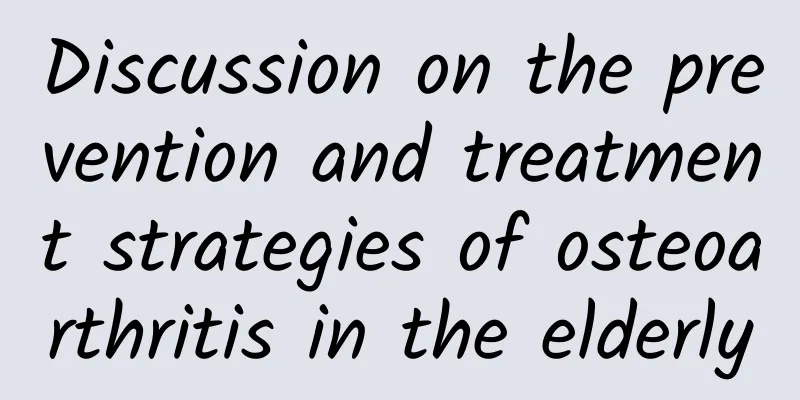Discussion on the prevention and treatment strategies of osteoarthritis in the elderly

|
With the aging of the population, osteoarthritis in the elderly has become an important factor affecting the quality of life of the elderly. Osteoarthritis in the elderly mainly includes fractures, osteoporosis, osteoarthritis, etc. These diseases not only bring physical pain to patients, but also may lead to inconvenience in movement, decreased quality of life and even disability. Therefore, it is of great practical significance to explore the prevention and treatment strategies of osteoarthritis in the elderly. 1. Causes of osteoarthritis in the elderly The occurrence of osteoarthritis in the elderly is related to many factors, mainly including the following aspects: 1. Age: With age, bone density gradually decreases, and the wear and degenerative changes of bone joints gradually increase, thereby increasing the risk of osteoarthritis. 2. Gender: Women’s bone density decreases faster than men’s due to decreased estrogen levels, so women are at a higher risk of osteoarthritis. 3. Genetic factors: Some bone and joint diseases have a genetic tendency, such as fractures, osteoporosis, etc. 4. Malnutrition: Long-term insufficient intake of nutrients such as calcium, phosphorus, and vitamin D can easily lead to reduced bone density and increase the risk of osteoarthritis. 5. Lifestyle habits: Long-term lack of exercise, sitting for long periods of time, smoking, drinking and other bad lifestyle habits may lead to the occurrence of bone and joint diseases. 6. Other diseases: Patients with endocrine diseases such as diabetes and hyperthyroidism have a higher risk of developing osteoarthritis. 2. Prevention strategies for osteoarthritis in the elderly In view of the causes of osteoarthritis in the elderly, we can prevent it from the following aspects: 1. Proper diet: Ensure adequate intake of nutrients such as calcium, phosphorus, and vitamin D to promote bone health. It is recommended to consume 1000-1200 mg of calcium, 800-1000 mg of phosphorus, and an appropriate amount of vitamin D per day. 2. Increase exercise: Appropriate exercise can enhance bone density and slow down degenerative changes in bones and joints. It is recommended to perform at least 150 minutes of moderate-intensity aerobic exercise per week, such as brisk walking, jogging, swimming, etc., and 2-3 times of resistance training per week, such as weightlifting, squats, etc. 3. Quit smoking and limit alcohol intake: Smoking and excessive drinking can have adverse effects on bone health and increase the risk of osteoarthritis. It is recommended to quit smoking and limit alcohol intake. 4. Maintain good living habits: avoid sitting for long periods of time, maintain correct sitting and standing postures, and reduce pressure on the spine and joints. 5. Regular physical examinations: Regular bone density examinations can be performed to detect and intervene in the occurrence of osteoarthritis in a timely manner. For high-risk groups, such as those with a family history or long-term use of hormone drugs, more attention should be paid to regular physical examinations. 3. Treatment strategies for osteoarthritis in the elderly The treatment methods for different types of geriatric osteoarthritis are also different: 1. Fracture: Fracture treatment mainly includes conservative treatment and surgical treatment. Conservative treatment mainly stabilizes the fracture site and promotes fracture healing through plaster fixation, external fixation and other methods. Surgical treatment uses internal fixation, external fixation and other methods to stabilize the fracture site on the basis of fracture reduction. For elderly patients with more underlying diseases, the appropriate treatment plan should be selected after comprehensively considering the patient's physical condition and fracture type. 2. Osteoporosis: The treatment of osteoporosis mainly includes drug therapy and non-drug therapy. Drug therapy mainly improves bone density by supplementing calcium, vitamin D, estrogen and other drugs. Non-drug therapy mainly promotes bone health by increasing exercise, improving lifestyle habits and other methods. For patients with osteoporosis, they should choose the appropriate treatment plan according to their condition. 3. Osteoarthritis: The treatment of osteoarthritis mainly includes drug therapy, physical therapy and surgical treatment. Drug therapy mainly relieves joint inflammation and pain through non-steroidal anti-inflammatory drugs, glucocorticoids and other drugs. Physical therapy includes heat therapy, cold therapy, electrotherapy, etc., which can improve joint function and relieve pain. Surgical treatment is mainly for patients who are not well responded to drugs and physical therapy, and joint replacement surgery can be considered. IV. Rehabilitation and nursing of osteoarthritis in the elderly 1. Rehabilitation exercise: Rehabilitation exercise helps improve the quality of life and work ability of the elderly. The elderly can choose a rehabilitation exercise method that suits them according to their physical condition, such as walking, Tai Chi, yoga, etc. At the same time, they can also do muscle strength training and flexibility training to enhance muscle strength and flexibility. 2. Psychological care: Elderly patients with osteoarthritis often have psychological problems such as anxiety and depression. Psychological care can help patients adjust their mentality and face the disease and treatment process positively. At the same time, psychological care can also improve patients' self-confidence and quality of life. 3. Family care: Family care is very important for elderly patients with osteoarthritis. Family members should give patients enough care and support to help them maintain a positive attitude and life attitude. At the same time, family members should also pay attention to the patient's diet, daily life and safety issues to avoid accidents. In short, the prevention and treatment of osteoarthritis in the elderly requires comprehensive consideration of the patient's age, gender, genetic background, lifestyle and other factors to develop a personalized prevention and treatment plan. At the same time, strengthening health education and improving the elderly's understanding of osteoarthritis and self-care awareness are also important measures to prevent and treat osteoarthritis in the elderly. (Wang Mengran, Mencheng Community Health Service Center, Mentougou District, Beijing) |
<<: Health Science | Causes and Countermeasures of Nosebleeds in Patients with Blood Diseases
Recommend
After ovulation, the body temperature is always 37 degrees.
For normal people, their body temperature is gene...
Mastectomy
Abnormal sensations in the breast require treatme...
Miscarriage at 47 days of pregnancy
Pregnancy and miscarriage are topics that every w...
Why haven't you had your period for 40 days?
Girls are girls when they are young, and when the...
Does low 25-hydroxyvitamin D mean calcium deficiency?
This is the 3154th article of Da Yi Xiao Hu Osteo...
Soup suitable for menstruation
Menstrual health care is very important for women...
What happens when you are about a week pregnant?
After a woman becomes pregnant, she will experien...
Is it normal to have frequent fetal movements after entering the pelvis?
Pregnancy is a gradual process. Entering the pelv...
Why do pregnant women feel nauseous when they are hungry?
Pregnant women are likely to experience uncomfort...
What race are there in Mexico? Is Mexico's economy considered a developed country?
The United Mexican States, or Mexico for short, i...
Cookies? No, it's Hepatitis C!
Author: Niu Xiaoxia, deputy chief nurse of the Fi...
How is Zhuge Liang described in Romance of the Three Kingdoms? What are Zhou Yu's personality traits in Romance of the Three Kingdoms?
The Romance of the Three Kingdoms is the first ch...
How to treat yang deficiency
Traditional Chinese Medicine is my country's ...
How to make pickled cucumbers crispy and not soft
Cucumber is a common vegetable, and there are man...
An octogenarian is restricted from going to the hospital due to salt restriction in order to control high blood pressure? Is it true that lighter food is not better?
Salt is very important to the human body, and acu...









